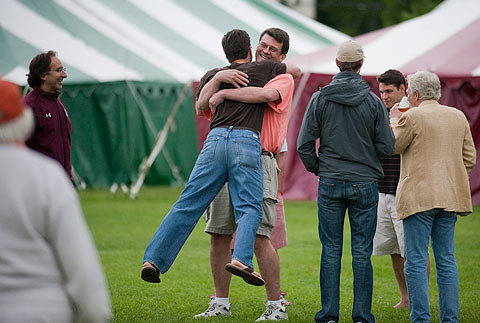![]() About 1,400 alumni returned to campus this past weekend, filling Whitnall Field with laughter and shared memories, offering provocative Reunion College sessions, and celebrating milestones and achievements.
About 1,400 alumni returned to campus this past weekend, filling Whitnall Field with laughter and shared memories, offering provocative Reunion College sessions, and celebrating milestones and achievements.
In typical Chenango Valley fashion, the weather mostly cooperated, intermingling overcast skies with sunshine. The traditional All-Class Parade and Torchlight festivities were enjoyed by all; fireworks filled the air Friday night; and the Class of 1969 provided a band that had its tent jumping on Saturday evening.
Alumni and their families and friends also had a chance to get into the classroom and take part in active discussions during the dozens of Reunion College sessions.
 |
| Members of the Swinging ‘Gates a cappella group serenade a member of the Class of 1959. SEE MORE PHOTOS HERE. (Photo by Andy Daddio) |
Here is a sampling of the sessions:
• Albert Bartlett ’44, professor emeritus of physics from the University of Colorado, explained the simple arithmetic that he says shows why “sustainable growth” is an oxymoron, in “Why Scientists Succumbed to Political Correctness.”
“The greatest shortcoming of the human race,” he began, “is our inability to understand the exponential function.”
In a talk chock-full of data, graphs, and occasional humorous cartoons — sprinkled with reality-check quotes from historical figures from Galileo to Churchill to Aldous Huxley (“Facts do not cease to exist because they are ignored”), Bartlett explained the mathematics of exponential growth and drew a clear picture of what he says is the forgotten fundamental of the energy crisis, and the problems that lie ahead for future generations in the areas of resources and population.
It’s society’s addiction to growth, which occurs on an exponential basis, he says, that simply cannot be sustained.
While acknowledging that it may be politically incorrect to encourage factors that would decrease the world’s population (war, disease, famine), he observed, “It’s intellectually dishonest to talk about saving the environment without stressing the obvious fact that stopping population growth is a necessary condition for sustaining the environment.”
• Audience members got an inside look into a sports director’s studio with Drew Esocoff ’79, who directs NBC’s Sunday Night Football and has 25 years of experience in the sports television business.
Using a Denver vs. San Diego football game as an example, Esocoff showed the audience a version of what he looks at when directing: 20 cameras simultaneously broadcasting different views of the game, among which he chooses and directs the technician to telecast.
Comparing his role to a quarterback’s, Esocoff said he is responsible for keeping the show moving on a second-to-second basis while the producer serves as the “head coach” by talking to the announcers, handling replays, and managing the network responsibilities.
Esocoff explained that in addition to knowing which shot makes sense, another critical part of his role is presenting a balanced story. “One of the key things of being an in-tune director is knowing that there are two sides to every story. We call them heroes and goats – if a wide receiver makes a great catch for a touchdown, there’s going to be a defensive back who got beat,” he said. “Neither one of these stories is more important than the other.”
• A native of Littleton, Colo., where the 1999 shootings at Columbine High School occurred, Stephanie Stillman ’99 presented her research on how the shootings have affected the community in her talk, “The Making of Martyrs and Monsters: The Politics of Memory in the Aftermath of the Shootings at Columbine High School.”
“When I went home, and over the years, I was struck repeatedly of the ways in which there was so much pressure on the community – and much of that was within the community itself – to push for closure and healing,” she said.
Through interviews and media analysis, Stillman studied the shooting’s aftermath for her PhD dissertation while at the University of California Santa Barbara. She plans to publish her results in a forthcoming book, Remembering the Cruelest Month.
Stillman found that because the community was not allowing itself to fully grieve, people were searching for quick answers and solutions. Thus, many adults in the community used the events to advance their own religious and political agendas.
She explained that these various agendas have divided the community, which is still haunted by the “martyrs” – the 13 who were shot and killed – and the “monsters” – the two students who were responsible.
 |
| Alumni greet each other on Whitnall Field. SEE MORE PHOTOS HERE. (Photo by Andy Daddio) |